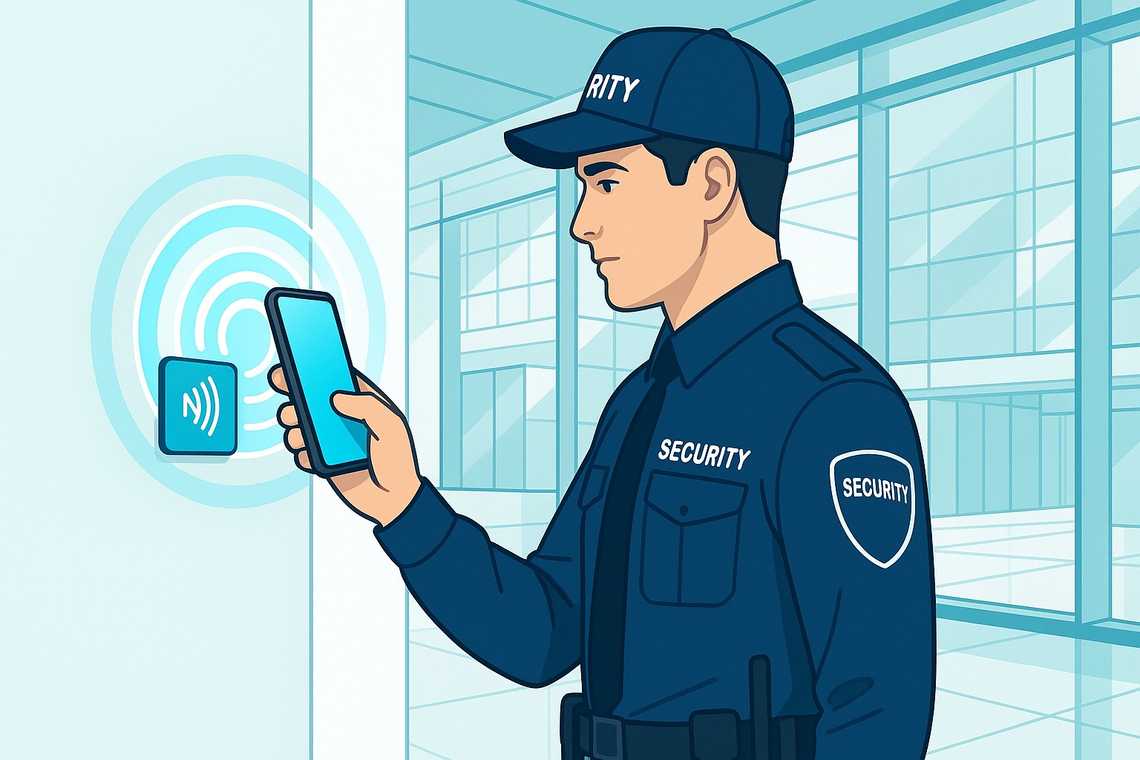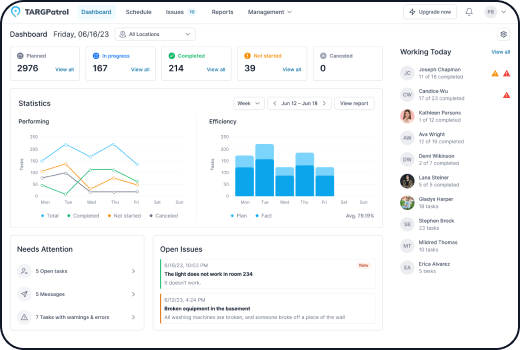Enhancing Security Management with NFC Tags in 2025

Near Field Communication (NFC) technology enables precise tracking of patrol guards by allowing them to scan NFC tags at different checkpoints during their rounds. NFC tags for guard tracking systems have transformed patrol operations. Both security officers and clients can now access real-time information about guard locations, greatly improving situational awareness and giving security companies a strong competitive advantage.
The Advanced Guard Tour System with NFC Tags enables security companies to deliver reliable protection and increase guard accountability. If your company hasn’t adopted NFC Tags for Guard Tracking, now is the time to consider it. This technology helps build your reputation as a trustworthy security provider. We’re here to assist you with selecting the right Guard Tour System, but let’s start by exploring the essentials of NFC tags and how they work.
NFC Purchasing Guide: Key Factors to Review Before Choosing NFC Solutions
NFC tags are widely used for guard tours and come in several types. Below, we outline the leading NFC tag variants currently available.
Discover how NFC tags function within a Guard Tracking System.
NFC Purchase Guide: Key Factors to Evaluate Before Choosing NFC
Investing in technology goes beyond just spending money and finalizing a purchase. It’s important to understand exactly how the technology will benefit your operations. NFC Tags, for example, can significantly enhance security guard patrol processes. To ensure your investment is effective and delivers maximum value, consider these key questions before choosing NFC Tags for your Guard Tracking System.
How do you want to use NFC Tags?
The way you deliver security services can benefit from NFC Tags in several ways, such as tracking security guards’ locations at client sites. With a modern Security Guard Tracking System, you always know each guard’s real-time position and can keep your clients updated as well.
What types of NFC form is suitable for your purpose?
There are two types of NFC forms—NFC Tags and NFC Stickers. NFC Tags are especially beneficial for security guard companies, as their improved locking system ensures they remain securely attached to a security guard’s uniform during daily operations and patrols. This reliability helps maintain accurate attendance and activity records. On the other hand, NFC Stickers are mainly used in the retail industry, where they can be easily placed on products, shelves, or displays for inventory management, product authentication, or customer engagement. Both forms support efficient tracking and reporting, but their applications vary based on operational needs.
What is the ideal range of the NFC tags for your use case?
Many types of NFC tags are available, including options that provide long-range coverage. However, for a reliable Guard Tour System, it is best to use short-range NFC tags. Short-range tags ensure that information is transmitted to the software instantly, reducing the risk of interference or unauthorized access. This approach helps keep both the security guard’s data and their precise location secure, supporting accurate monitoring and compliance. By choosing short-range NFC tags, you enhance the reliability of your patrol operations and maintain a higher standard of data protection for your team and facilities.
What cost & benefits of NFC Tags you buy?
You must carefully evaluate both the costs and benefits when choosing technology for your business. Consider not just the initial purchase price, but also long-term value, ease of use, and how well the solution fits your team’s needs. The best NFC Tags are those that offer the most advantages—such as reliability, compatibility, and ease of integration—relative to their cost. By weighing these factors, you ensure that your investment delivers the greatest possible benefit to your operations.
Best NFC Tags For Guard Tour Tracking System
Wet Inlay Tags:
For indoor NFC tagging, Wet Inlay Tags are an excellent choice. They are simple to apply to nonmetal surfaces or glass doors. If your security team is stationed at a retail store or other indoor site, these tags offer great value. Before purchasing Wet Inlay NFC Tags, ensure you understand their reading distance and how they attach.
On-Metal NFC Tags:
These NFC tags are designed for use on metal or electronic surfaces and are available as either stickers or tokens. Stickers are best for indoor use, while tokens are more suitable for outdoor environments. Token-style On-Metal NFC tags are waterproof, heat-resistant, and built for durability.
Heavy Duty NFC Tokens:
Heavy Duty NFC tags are ideal for challenging settings where regular NFC tags might not be reliable. Built to withstand moisture, extreme temperatures, and harsh conditions, they ensure dependable performance in demanding situations.
About Low-Cost Chinese NFC Tags:
Many businesses consider using affordable NFC tags sourced from China to track guards or manage tasks. While these tags offer a budget-friendly solution, it’s important to keep the following in mind:
- Cost Savings: Bulk purchasing can significantly reduce expenses for large-scale deployments.
- Compatibility: Ensure the tags work with your current devices and management platforms like TARGPatrol.
- Quality Variations: Quality and durability may differ between manufacturers, so request samples before committing to a large order.
- Supplier Reliability: Choose reputable suppliers to avoid counterfeit or non-functional products.
Integrating these tags with TARGPatrol can streamline asset tracking and task management, but always balance cost with reliability to maintain operational efficiency.
Why Are NFC Tags Becoming More Popular in the Security Patrol Industry?
While Near Field Communication (NFC) has been around for some time, its modern applications are especially noteworthy. NFC Tags have become increasingly valuable in today’s mobile-driven environment. When paired with wireless solutions such as (Guard Tour Software)[https://targpatrol.com/blog/security-guard-tour-app-to-keep-team-organized/], NFC Tags offer a wide range of possibilities.
Research from 2015 indicated that NFC Tag shipments were expected to reach 785 million, and this number has grown significantly since. Today, NFC Tags play a key role in enhancing productivity, service quality, and accountability for security patrol teams.
How NFC Tags For Guard Tracking System Work?
NFC Tags use two-way wireless communication to transfer essential data to the connected Guard Tour System. The Guard Patrol System can both read and write small amounts of data, sending information instantly to the intended recipient. Security guard companies benefit from NFC Tags in several ways, including:
- Faster response: Real-time data transfer enables supervisors to give immediate incident prevention instructions.
- Accurate time and attendance tracking: NFC Tags are only readable within range of an NFC frequency reader, preventing time and attendance fraud.
- Advanced technology: NFC Tags aren’t just for today’s needs—they support future applications. Security companies can collect valuable business intelligence, supporting forward-thinking operations.
NFC Tags for Guard Tracking Systems are gaining significant attention. Beyond the uses above, when paired with a reliable Guard Patrol System, NFC Tags help security companies track and locate guards during patrols.
Combined with GPS Tracking and GeoFencing, this technology ensures patrol operations remain uncompromised. Supervisors can monitor, record, and store patrol routes for future reference—making it easier to assess operational efficiency and identify areas for improvement.
Which NFC Applications Should You Evaluate Before Making an Investment?
NFC uses electromagnetic radio waves to allow devices like smartphones, tablets, and wearables to communicate and share data without physical contact.
Common uses and applications of NFC include:
Contactless Payments:
NFC is commonly used for making payments without cash or cards. Users can tap their NFC-enabled devices, such as smartphones or smartwatches, on supported payment terminals. Services like Apple Pay, Google Pay, and Samsung Pay use NFC for secure and easy transactions.
Ticketing and Access Control:
Secure NFC tags are used in ticketing for events, public transport, and access systems. NFC-enabled tickets or smart cards can be tapped on compatible readers for quick and convenient entry or access validation.
Data Transfer and File Sharing:
Leading NFC tags allow for quick and effortless data exchange between devices. By placing two NFC-enabled devices close together, users can easily share files, contacts, photos, videos, and other information with a simple tap or gesture.
Device Pairing and Bluetooth Connectivity:
NFC technology streamlines the process of connecting devices via Bluetooth. Users can pair two devices by tapping them together, removing the need for manual Bluetooth setup.
Smart Tags and NFC-enabled Objects:
NFC tags or stickers can be set up to trigger specific actions when tapped by an NFC-enabled device. For instance, an NFC tag on your nightstand could activate an alarm, dim the lights, and set your phone to silent mode all at once.
Mobile Ticketing and Loyalty Programs:
NFC supports mobile ticketing, letting users store electronic tickets for events, travel, or public transport directly on their smartphones. It also powers loyalty programs, allowing users to collect and redeem rewards by tapping their devices at participating locations.
Internet of Things (IoT) Applications:
NFC plays a key role in the IoT landscape by enabling devices and objects to communicate seamlessly. For instance, in smart homes, users can manage automation systems by interacting with NFC-enabled devices.
Healthcare and Identity Verification:
In healthcare, NFC technology supports secure patient identification, safe access to medical records, and medication tracking. NFC-enabled devices help transmit and store patient details securely, boosting accuracy and efficiency. Strengthening NFC security will bring long-term benefits to healthcare organizations.
Guard Patrol Systems like TARGPatrol use NFC Tags to improve patrol processes. If a checkpoint is missed, supervisors are notified and can follow up to understand the cause. NFC Tags offer a modern, efficient solution for the security industry, promoting accountability and precision in operations.
Conclusion
NFC tags are transforming the way security companies manage patrol operations, offering a simple yet powerful solution for real-time tracking, accountability, and data-driven decision-making. By selecting the right type of NFC tags and integrating them with a reliable Guard Tour System like TARGPatrol, businesses can streamline their processes, reduce errors, and enhance overall security performance. As the demand for efficient, transparent, and reliable security solutions grows, adopting NFC technology positions your team to meet modern challenges with confidence. Investing in the right NFC solution today means building a safer, smarter, and more responsive operation for tomorrow.
Ready to Enhance Your Security Operations with NFC Technology?
Discover how TARGPatrol can help you implement NFC-based guard tracking, improve accountability, and streamline your security operations.
✅ Book a free demo today and see TARGPatrol’s NFC integration in action.
✅ Try it free and experience the difference for yourself.
Start using TARGPatrol today and discover how it can transform your security management operations.


